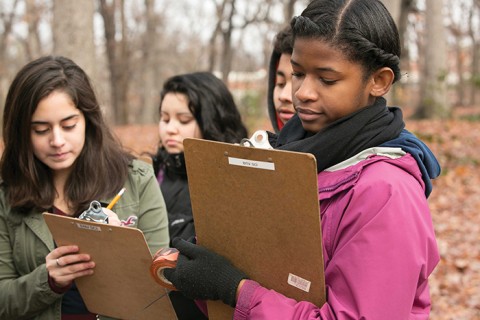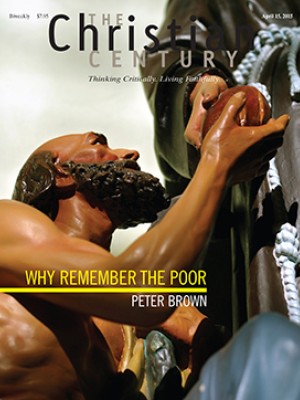Character traits: A model for learning service and responsibility
Past efforts at "character education" have operated with a shallow understanding of character. The Expeditionary Learning model goes deeper.

“Please take a look at today’s workshop target and tell me if you have a specific notice or a wonder about it.” John Exall was introducing his sixth-grade class to its next “expedition,” a semester-long project on American immigrant stories.
“Mattie, why don’t you start us off?”
These 11- and 12-year-olds were obviously accustomed to Exall’s approach and knew the lingo of “workshop target,” “notice,” and “wonder.” They responded immediately.
“I notice that we are going to be using some texts to do this,” said Mattie.
“Ben?”
“My question is what is an ‘immigration case study.’”
“Great question, Ben.”
Over the coming weeks, these students at Odyssey Expeditionary Learning School, a public charter school in Denver, paired their academic work with personal experience. They traveled to El Paso, Texas, to meet groups working on border issues. They stood across the fence from children their own age. They listened to anti-immigration groups talk about their beliefs. And at every stage of the process, the teacher was interested not only in whether they were acquiring academic knowledge and skills but whether they were developing traits of compassion, service, inquiry, and responsibility.
Read our latest issue or browse back issues.
Even in the first lesson, where the focus on academic learning was obvious, a carefully constructed lesson in character was being given.
“Give me a pinky,” Exall said. “Hold the pinky way down low if you have no idea what a primary source document is and way up high if you are like, ‘Primary source documents, I’ve been working with them since I was born.’ OK. I see a real mix within the crew.”
The project began with this honest, low-stakes assessment of one’s own place in the process of learning. The class was already helping to foster community and humility.
Since its earliest days, American public education has been concerned with moral as well as intellectual development. Early character education, says historian Michael Watz, meant simply using the Bible to teach reading and writing. The 19th-century education reformer Horace Mann underscored the importance of teaching morality and civic virtue. The question of what morality means and how to instill it in children has been a topic of debate for as long as there have been public schools.
In recent decades, with demographic and social changes in American culture, urbanization, and the institution of high-stakes federally mandated testing, the question of how to teach character has become increasingly fraught. The Christian school movement that emerged in the 1980s, says Watz, contended that “public schools existed in a moral void.” They could not possibly teach character, the argument went, because they themselves had no moral foundation.
In the 1990s, as a response to the accusations of the religious right and to a widespread sense that public schools were plagued by violence and disorder, President Clinton encouraged “character education.” The Partnership in Character Education Pilot Project used federal funds to institute new programs, and private organizations like Character Counts! supplied schools with materials and curricula.
Character Counts!, the largest paraschool organization focused on character education, provides curricula on specific areas, such as trustworthiness, caring, and respect. A group known as PBIS (Positive Behavior Interventions and Supports) works with schools to create reward and consequence systems to encourage good behavior.
The problem with such efforts, says Alfie Kohn, an education advocate, is that they confuse character and behavior. Their goal is to make children conform to models of behavior that make the lives of adults easier.
“What goes by the name of character education nowadays,” Kohn wrote in his widely read essay “How Not to Teach Values,” is mostly “a collection of exhortations and extrinsic inducements designed to make children work harder and do what they’re told.”
These programs work with a shallow understanding of character and haven’t even been proven to work. After surveying the research, Kohn concluded that “the more we reward people for doing something, the more likely they are to lose interest in whatever they had to do to get the reward.” Character education that rewards good behavior has the confounding impact of devaluing the behavior being called good.
As an alternative, the Expeditionary Learning model followed at Exall’s school integrates character education into everything it does. The model is based on such principles as “self-discovery,” “having wonderful ideas,” and “responsibility for learning.”
In launching the expedition on immigration, Exall almost immediately turned the lesson over to the students for their project of discovery. He did not even read the “workshop target” on the board before inviting students to wonder about it. The responsibility for the work of learning lies with the student, and teaching this truth is one brick in the construction of a moral human being—and an important contrast with character-education programs that mete out rewards for compliant behavior. Exall shared the power with the students as they offered thoughts about what “primary source” means, and he demonstrated that he valued their wonderings.
Other crucial principles of learning were also at work. When Exall said, “I see a real mix among the crew,” he was using a term that underscores EL’s interest in developing community.
“Crew,” said EL regional director Jon Mann, “is foundational to everything we do.” EL teachers are trained to look for “full and even participation” and to craft exercises in which the work of any one student is dependent on the others.
Mann said the focus on being part of a crew also allows discipline problems to be handled differently. Teachers rarely send children out of the classroom to deal with a discipline issue. Rather, the teachers raise the question of behavior in the context of its impact on the crew.
Connected with the concept of crew are other principles of Expeditionary Learning: service and compassion, empathy and caring, and diversity and inclusion. An emphasis on being part of the crew does not mean conformity. Mann points out that children are encouraged to express themselves through both voice and dress.
“You notice in the classroom that kids have hats on; they all have their own thing. That is what we want. We want them to come to us as they are, and not have to be somebody else because of the adults’ rules.”
Finally, Exall demonstrated what Odyssey calls “revision,” or what the EL literature calls the experience of “success and failure.” Since trial and error are crucial for the process of learning, students are given practice at trying out ideas, and as the Odyssey school motto has it, “leaping in, getting stuck, and pushing through.” This is how character is developed.
EL teachers, administrators, and school designers carefully think about how EL principles can be included in the lessons without being heavy-handed.
At Odyssey, values are refined into “habits,” and within habits performance character skills are distinguished from relationship character skills. Character is defined not as something a person is, but as a “set of skills students own.” Some of the habits are tracked and progress is noted. In the third, fifth, and eighth grades, children are responsible for presenting evidence of having attained habits of inquiry, responsibility, service, collaboration, revision, and perspective-taking (empathy).
The principles of EL also inspire the teachers at Lake County Intermediate School in Leadville, Colorado. The school district has struggled to improve student test scores, and it was put on probation by the state in 2009. It made several attempts to improve performance with little success.
Last year, the school turned to EL in an attempt to refashion school culture as well as improve academic performance.
I asked third-grade teacher Dan Leonhard to talk about the difference EL made in his work.
“Before, as a teacher, I might have said to a kid I was having a problem with, ‘These are my expectations. Here’s where you are not meeting them and here are the consequences.’ Now, I say, ‘You and I agreed that patience was something we were working on this year. Where would you say you are in developing more patience? What are some examples of that?’ The kids get invested in the process.”
Knowing that his class is working on acquiring the trait of perseverance, Leonhard every week puts on the board a math problem that is too hard for the students. He calls it a “Grapple.” Instead of praising the student who gets it right or who makes the most progress in solving it, he highlights what he calls “the mistake of the day.”
“Who can make the mistake of the day?” he asks. The mistake of the day is the one that helps other students learn the most.
At the beginning of the year, he says, students would drop their pencils when the “Grapple” came onto the board and complain, “It’s too hard,” and “I can’t do it.” Now, he says, his class competes to see who can make the mistake of the day. They leap out of their seats to put their responses on the board even knowing that they will probably be wrong.
The language used by each Expeditionary Learning school is specific to that school, but they share a common origin in the work of Kurt Hahn (1886–1974), a German-Jewish educator who was headmaster at the Salem Castle School, a private boarding school in Germany. During Hitler’s regime, the staff at Salem was asked to sign a loyalty pledge to Hitler, and all refused. Hahn was put in prison. Influential friends in Great Britain worked to free him, and he was released on the condition that he leave Germany. He went to Scotland, where he became headmaster at Gordonstoun and continued to refine the educational model he developed at Salem.
In Scotland, Hahn converted to Christianity and came to view the parable of the Good Samaritan as fundamental in his own philosophy of education. His question became: How do we educate people capable of being Good Samaritans?
Knowledge in and of itself is insufficient, he decided. Young people needed training in virtue, bravery, self-reliance, and curiosity. His model of education came to include the need for diversity in ethnic background and social class in the classroom; rescue and first responder training; physical, emotional, and mental fitness; and intentional teaching of empathy, caring, and compassion.
The story of the Good Samaritan is, in Hahn’s reading, a universal paradigm that encourages people to look beyond their boundaries and form social bonds with people different from themselves. In this way, it may be particularly, perhaps surprisingly, relevant to 21st-century education.
Hahn’s educational proposals took many different forms over the next several decades. In the United States, they led most famously to Outward Bound—an organization offering outdoor adventures for individuals or groups. (Hahn is also credited with creating the models that led to the International Baccalaureate programs and United World Colleges.)
In the early 1990s, a group of educators largely from Harvard wondered if Hahn’s principles could be reconfigured to answer the crisis in American public education. The Harvard group wrote up ten “design principles” and founded Expeditionary Learning as a nonprofit organization to experiment with how Hahn’s principles might be adapted for public schools.
In 1993 five schools agreed to experiment with Expeditionary Learning. These ranged from a school startup in New York to a long-established elementary school in Dubuque, Iowa. Scott Gill, a school designer for the Expeditionary Learning organization, was a teacher in the Dubuque school when EL was introduced. He said he took the EL proposal home for the weekend and connected immediately. “This was exactly what I wanted my classroom to be,” he said.
The core teaching practice of Expeditionary Learning is the expedition—a demanding project that requires multiple skills, creativity, and teamwork. After Exall’s classroom finished the expedition on immigration, it began a science-oriented expedition on water quality that had the students tromping through the local Platte River, taking water samples, analyzing the samples, and discussing and writing about the problem of water quality in the region. One wall in the school was dedicated to housing waders and boots.
Hahn said, “It is the sin of soul to force young people into opinions—indoctrination is of the devil—but it is culpable neglect not to impel young people into experiences.” Through experiences, young people are shaped as learners and as human beings, and they will once again have the opportunity to put principles into action to create habits.
Implementing this vision remains a challenge for Odyssey and perhaps all Expeditionary Learning schools. “It has been fairly easy to get people on board to identify what the habits are and what the specific targets are,” said Mann. “The challenge is making them actionable in the classroom and really making sure that time is given to unpack the [character] targets and to make them happen.”
In an era when commentary on public schools is dominated by talk of test scores, Expeditionary Learning schools are under constant pressure to demonstrate that their methods create good test-takers as well as good human beings. EL leaders continue to talk about fostering an “expanded notion of success.”
The building of character is long-term work. It isn’t accomplished in one expedition or in one year or by one heroic teacher. Character comes from skill, habit, and practice.
“This is about growing trees, not about planting one garden,” Mann said. “We try to build the system and structures so that people understand this is a way that we operate regardless of individuals.”
“I think our message of an expanded notion of achievement is hard to hear,” said Mann. “People get it, but when it comes to institutions and politics, it is too complex a concept to be grasped. We try just to keep asking for them to think more broadly than they do now.”
Read the sidebar article on the laws of Expeditionary Learning.






